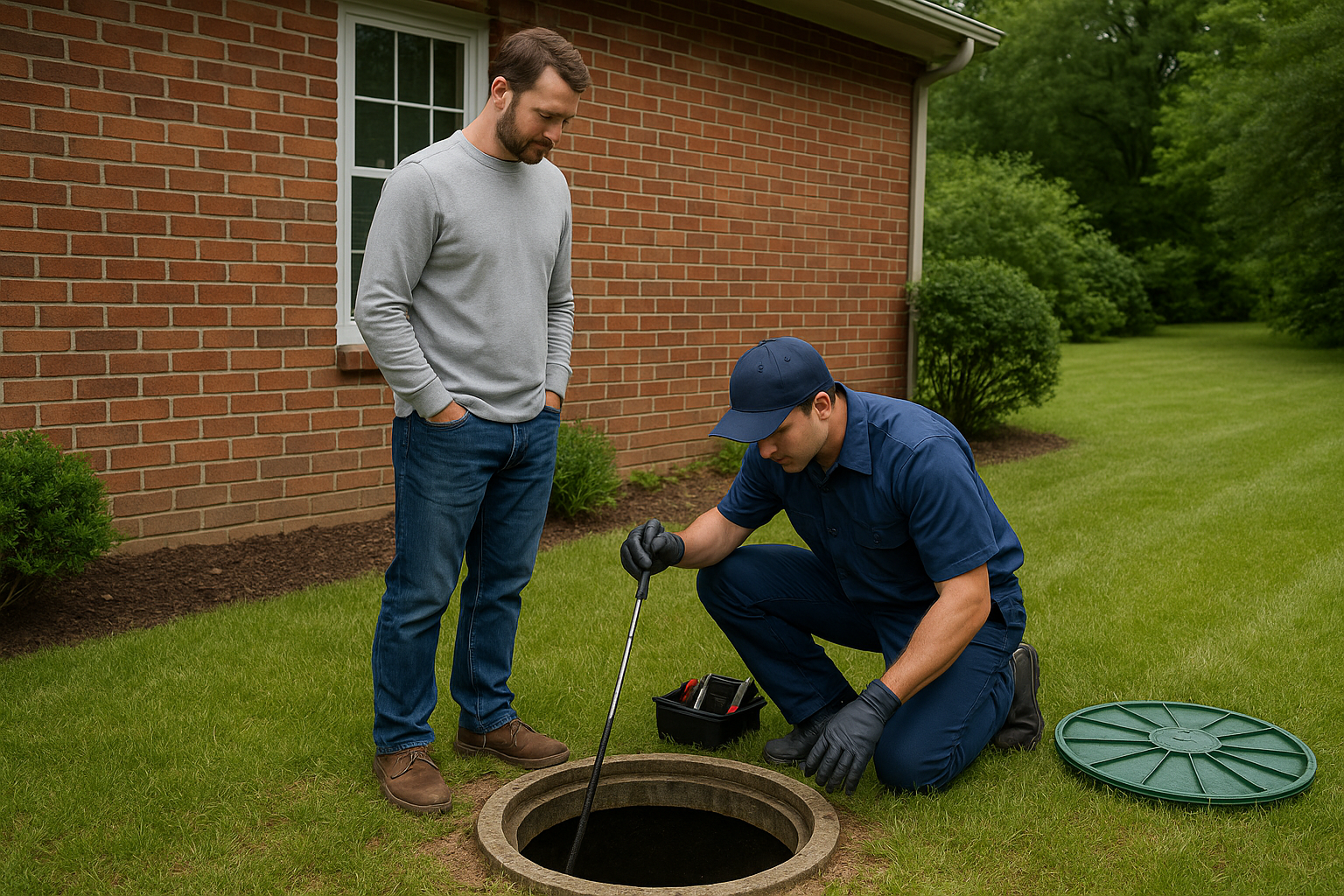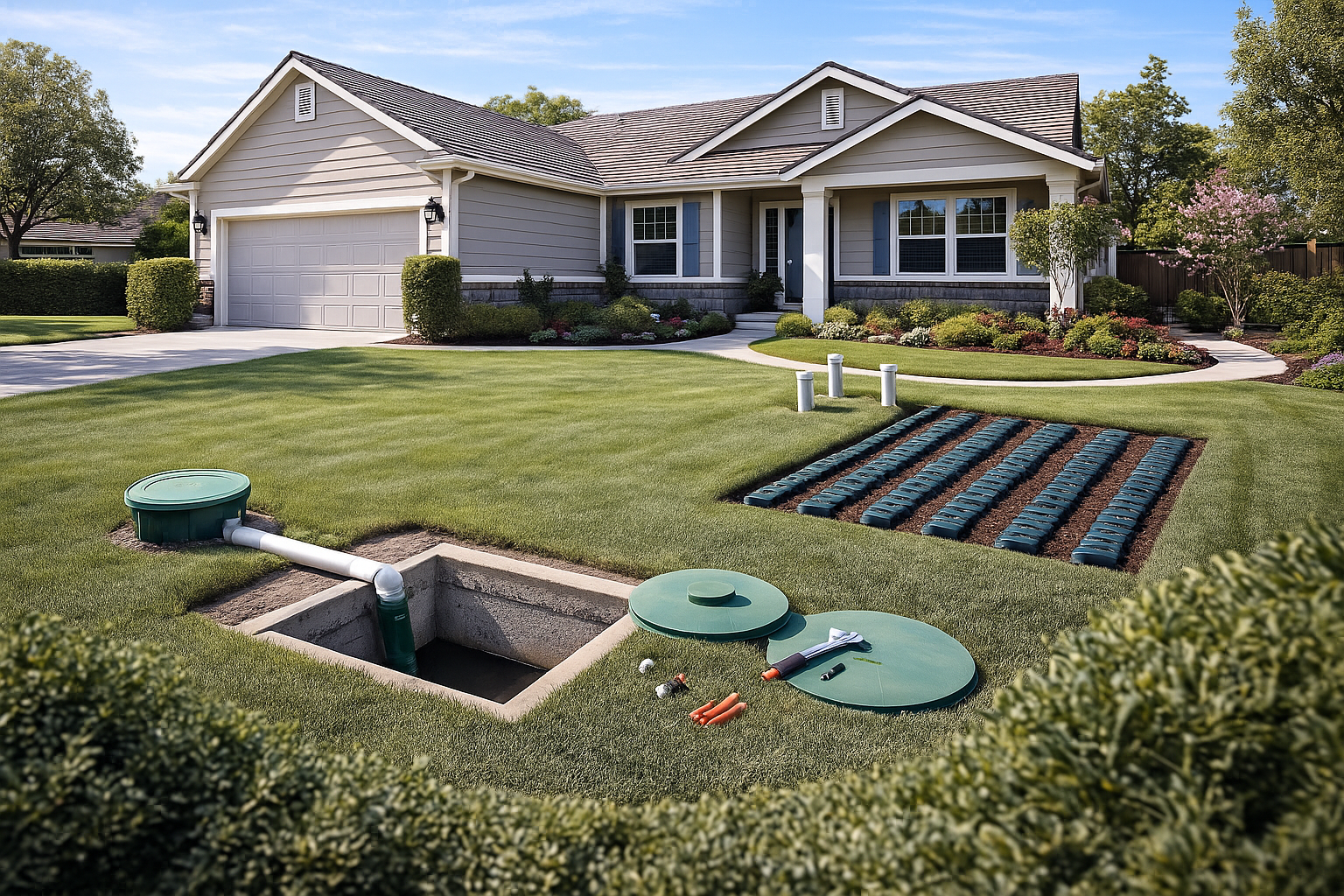Understanding How Septic Systems Evolved
Modern septic systems have come a long way from their early, basic designs. Early systems often relied on simple underground tanks that lacked the proper filtration and treatment processes we have today. Over the years, innovations have focused on improving septic tank longevity and environmental safety. Today’s advanced systems can last for decades when properly maintained.
Septic tank longevity depends on how well homeowners understand their system’s unique structure and needs. Many modern systems are designed with durability and eco-efficiency in mind, using materials that resist corrosion and promote better bacterial balance.
To help your septic system last 30+ years, it’s crucial to know how it works. A typical setup includes:
- A septic tank: collects and separates waste.
- A drain field: filters effluent through soil layers.
- Beneficial bacteria: break down organic matter naturally.
For a closer look at the pump-out process, check out how septic pump trucks work to understand what happens during professional maintenance. These components work together, and neglecting one can shorten the system’s lifespan. Proper maintenance and inspections are now considered essential steps to extend septic system lifespan. Understanding these fundamentals helps prevent septic tank failure and ensures your investment lasts decades.
The Core Factors That Influence Septic Tank Lifespan
Your septic system’s durability depends on a combination of installation quality, usage habits, and regular care. Poorly installed or undersized systems often fail early, while those maintained correctly can easily surpass 30 years. Septic tank maintenance tips often emphasize the importance of routine inspection, proper pumping frequency, and mindful waste disposal.
Some key factors include:
- Pumping frequency: Regular septic tank pump-outs prevent overflow and clogs while keeping your system compliant with local regulations.
- Water usage: Excess water can flood the system and reduce efficiency.
- Drain field health: Maintaining soil quality ensures proper filtration.
- Additive quality: Using natural septic tank treatments can boost bacterial health.
Neglecting these elements can result in costly septic tank repair service needs or full system replacement. Septic system cleaning schedules help manage buildup and improve performance, while avoiding harsh chemicals preserves essential bacteria.
Additionally, drain field maintenance and avoiding compacting soil above the tank prevent long-term damage. By following these practical septic tank care methods, homeowners can increase septic tank efficiency and achieve long-lasting systems that remain cost-effective and reliable.
Benefits of a Well-Maintained Septic System
Proper septic tank care goes beyond avoiding repair costs—it helps protect your property and the environment. A well-maintained system promotes efficient wastewater treatment, safeguarding groundwater and nearby ecosystems. Homeowners who practice consistent maintenance experience fewer septic backups, reduced odors, and longer system life.
Key benefits include:
- Lower long-term costs: Preventing septic tank failure saves thousands in replacements.
- Environmental protection: Eco friendly septic maintenance reduces pollution risks.
- Improved performance: Regular care enhances septic system health and flow.
- Home value boost: Reliable systems appeal to buyers and inspectors.
Consistent upkeep, such as following a septic system cleaning schedule and avoiding overuse of water, ensures efficiency. Using natural septic tank treatments also minimizes chemical damage while supporting bacterial balance.
If your home uses both a grease trap and a septic system, it’s important to understand their differences—learn more in this guide on grease traps vs. septic tanks. Creating a home septic care routine not only extends septic tank longevity but also ensures your system performs reliably every day.
Challenges That Affect System Longevity
Despite modern advancements, septic systems still face several challenges that can shorten their lifespan. Common septic tank issues stem from overuse, poor installation, and neglect. Homeowners often underestimate how small habits, such as flushing non-biodegradable items, can cause system failure. Excessive water use also stresses the drain field, reducing filtration capacity.
Frequent challenges include:
- Poor drainage: Causes overflow and flooding.
- Bacterial imbalance: Leads to sludge buildup.
- Soil compaction: Reduces drain field efficiency.
- Neglected inspections: Allows small problems to become major repairs.
Heavy rains and flooding are also major threats. Learn how to protect your septic system during heavy rain or flooding to avoid soil saturation and drain field damage.
By identifying risks early, homeowners can avoid costly septic repairs. Using a septic tank inspection checklist helps spot signs of wear before major issues occur. Preventive actions like drain field maintenance and professional septic services can make the difference between a system that lasts 10 years and one that lasts 30+.
Practical Steps for Extending Septic System Life
Homeowners can take actionable steps to increase septic tank efficiency and extend its lifespan. Regular upkeep is key, but it’s equally important to adopt smart daily habits that support your system’s health.
Follow these best practices:
- Pump regularly: Stick to your septic tank pumping schedule and avoid risky DIY pump-outs that could damage your system.
- Inspect annually: Use a septic tank inspection checklist to catch early issues.
- Limit water use: Avoid overloading the system with unnecessary wastewater.
- Use safe products: Choose eco friendly septic maintenance options.
- Protect the drain field: Prevent soil compaction and heavy equipment use.
Cost effective septic upkeep combines DIY septic maintenance with professional septic services. A long term septic maintenance plan ensures your system stays balanced and efficient. Also, avoid harsh detergents and antibacterial soaps that kill beneficial bacteria. Using natural septic tank treatments helps maintain bacterial balance and prevent clogs. These steps form the foundation of proper septic tank care—ensuring your investment remains reliable for decades to come.
Future of Septic Systems: Modern Innovations
The future of septic systems is focused on sustainability and smart monitoring. Modern systems use sensors to track water levels and alert homeowners to potential issues before they become costly. Advanced materials improve septic system design longevity, helping new installations last 40 years or more.
Emerging innovations include:
- Smart monitoring devices: Provide real-time data on tank performance.
- Bio-enhanced bacteria: Boost waste breakdown efficiency.
- Eco filtration systems: Improve soil treatment and reduce pollution.
- Renewable power integration: Supports energy-efficient septic operation.
Septic system care for homeowners is evolving toward automation and environmental responsibility. With these developments, long lasting septic systems will become the new standard. Septic tank additives review sites help consumers choose effective, natural products for maintenance.
By embracing new technologies, homeowners can protect their investment and support sustainability goals. The shift toward eco-friendly systems ensures that the next generation of septic tanks will require less maintenance and offer unmatched reliability.
Building a Septic System That Lasts
When constructing or upgrading your septic system, long-term planning is key. Selecting high-quality materials and hiring experienced installers directly affects performance and longevity. A well-designed system accounts for household size, soil type, and water usage.
Essential steps for building a durable septic system:
- Choose the right size: Ensure the tank suits your household needs.
- Test your soil: Drain field maintenance starts with proper soil testing.
- Install professionally: Avoid shortcuts that cause future issues.
- Plan for access: Make sure inspection and pumping points are easy to reach.
Working with professional septic services ensures the job meets all safety and regulatory standards. Residential septic solutions today focus on energy efficiency and minimal environmental impact.
Investing in the right system upfront saves you from costly septic tank repair services later. Long term septic maintenance plans and professional inspections help sustain efficiency. When properly built and maintained, your system can function smoothly for 30–40 years, delivering consistent results with minimal upkeep.
Final Thoughts on Septic System Longevity
Achieving septic system longevity is all about consistency, knowledge, and care. Whether you’re maintaining an older system or investing in a new one, your approach determines its lifespan. Implementing a septic tank inspection checklist, using natural treatments, and monitoring drain field health are crucial.
Remember these key takeaways:
- Maintenance equals savings.
- Eco-friendly care supports performance.
- Professional services prevent major damage.
- Knowledge helps avoid common septic issues.
By practicing good habits and scheduling regular maintenance, you can easily extend septic tank longevity beyond 30 years. The goal is not just to avoid septic tank failure but to create a sustainable system that benefits your home and the environment. With a proper septic system health guide and reliable care, your septic tank can remain efficient, safe, and long-lasting.






